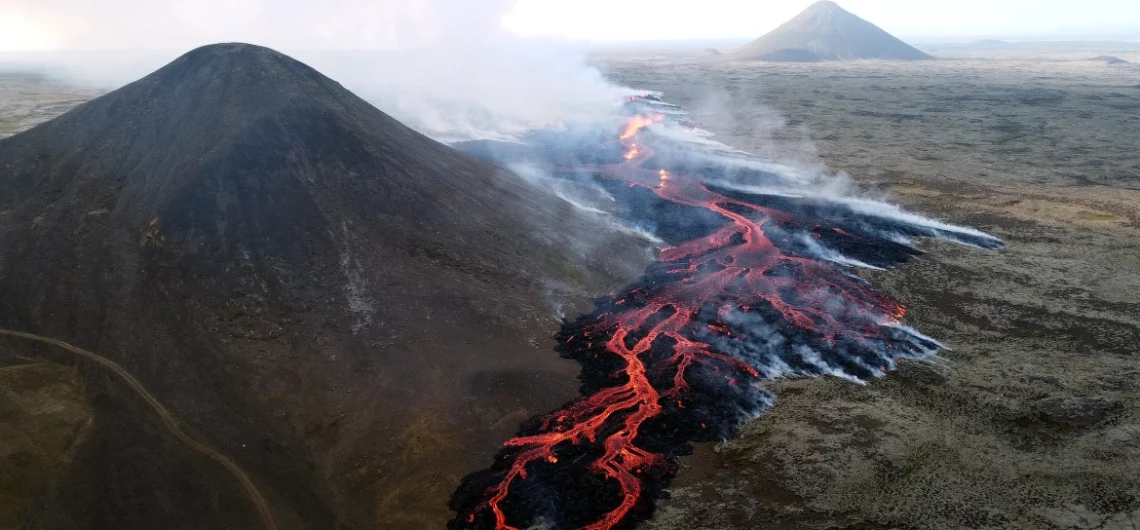After days of anticipation, an Icelandic volcano has begun to erupt. The Fagradalsfjall volcano is located on the Reykjanes Peninsula, just south of Reykjavik, Iceland’s capital and largest city.
This volcano has erupted for the third time in a year in two consecutive years.
Aside from being a renowned tourist destination, Iceland is a well-known hub for visitors traveling between the United States and Europe. Last year’s eruption had little effect on flights, and it remains to be seen whether the same will be true this time.
Iceland now has the most active volcanic systems in Europe, with 33.
The country’s meteorological service said that a volcano erupted in Iceland’s capital Reykjavik on Monday, the third time in two years that lava has spilled forth in the area.
Local media videos and images show a huge cloud of smoke rising from the ground, as well as a significant flow of lava at the location, which is around 30 kilometers (19 miles) north of Reykjavik.
“The eruption is taking place in a small depression just north of Litli Hrutur (‘Little Ram’ in Icelandic), from which smoke is escaping in a northwesterly direction,” according to the meteorological office.
“There are three fissures, with lava basically running in all directions,” said Thorvaldur Thordarson, a volcanology professor at the University of Iceland.
He noted that the fissures are around 200 to 300 meters long in total and that “it is a low intensity, effusive eruption.”
This implies that “it is not causing widespread threats due to explosive activity,” but “if the eruption continues for an extended period of time, it may pose a threat to infrastructure.”
Thousands of little earthquakes were reported in the vicinity in the week preceding the eruption, indicating that magma beneath the ground was moving and an eruption was likely.
The Icelandic authorities cautioned against visiting the location, which is located in rough terrain with no road access until they had assessed the situation.
The magma erupted at around 16:40 GMT, within a few kilometers of two previous eruptions in the last two years.
The first happened on March 19, 2021, in the Geldingadalur Valley and lasted six months, while the second occurred three weeks later on August 3, 2022, in the Meradalir Valley.
The area had been quiet for eight centuries before the 2021 eruption, but volcanologists anticipate the current cycle of heightened activity might continue for many years.
So yet, the effusive eruptions in this area have not been very threatening, nor have they disrupted aviation traffic.
The eruptions of 2021 and 2022 drew hundreds of thousands of people expecting to catch a rare sight of an active volcano.
Thordarson said that the eruption might continue anywhere from “a few days” to more than a half-year, or perhaps longer like it did in 2021.
Iceland now has the most active volcanic systems in Europe, with 33. It erupts every five years on average.
The North Atlantic island is located on the Mid-Atlantic Ridge, a rift in the ocean floor that separates the Eurasian and North American plates.
Following the major eruption of the Eyjafjallajokull volcano in April 2010, 100,000 flights were canceled, stranding almost 10 million passengers.
Other volcanoes, such as Askja in Iceland’s desolate highlands, have recently shown signs of activity.
Katla, on the country’s south coast, is one of the country’s most hazardous volcanoes. It last erupted in 1918, after which there was an abnormally extended hiatus, indicating an impending reawakening.
Some experts believe the 1783 eruption of the Laki volcanic fissure in the south of the island to be the most disastrous in Iceland’s history, creating the country’s worst environmental and economical disaster.
Read also about the active volcanic mountain, Ol Doinyo Lengai, that spews black lava.
![]()


Comments